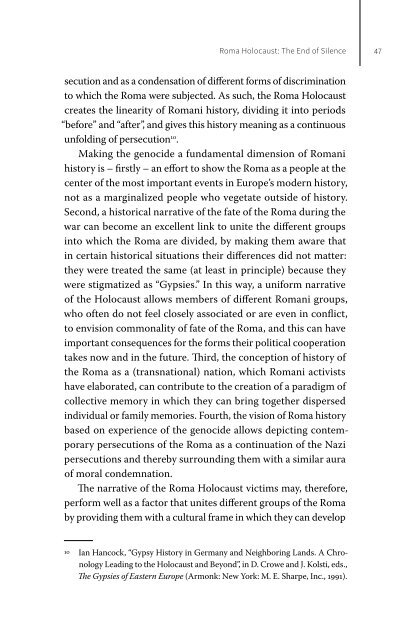EDUCATION FOR REMEMBRANCE OF THE ROMA GENOCIDE
Remembrance_2016
Remembrance_2016
You also want an ePaper? Increase the reach of your titles
YUMPU automatically turns print PDFs into web optimized ePapers that Google loves.
Roma Holocaust: The End of Silence 47<br />
secution and as a condensation of different forms of discrimination<br />
to which the Roma were subjected. As such, the Roma Holocaust<br />
creates the linearity of Romani history, dividing it into periods<br />
“before” and “after”, and gives this history meaning as a continuous<br />
unfolding of persecution 10 .<br />
Making the genocide a fundamental dimension of Romani<br />
history is – firstly – an effort to show the Roma as a people at the<br />
center of the most important events in Europe’s modern history,<br />
not as a marginalized people who vegetate outside of history.<br />
Second, a historical narrative of the fate of the Roma during the<br />
war can become an excellent link to unite the different groups<br />
into which the Roma are divided, by making them aware that<br />
in certain historical situations their differences did not matter:<br />
they were treated the same (at least in principle) because they<br />
were stigmatized as “Gypsies.” In this way, a uniform narrative<br />
of the Holocaust allows members of different Romani groups,<br />
who often do not feel closely associated or are even in conflict,<br />
to envision commonality of fate of the Roma, and this can have<br />
important consequences for the forms their political cooperation<br />
takes now and in the future. Third, the conception of history of<br />
the Roma as a (transnational) nation, which Romani activists<br />
have elaborated, can contribute to the creation of a paradigm of<br />
collective memory in which they can bring together dispersed<br />
individual or family memories. Fourth, the vision of Roma history<br />
based on experience of the genocide allows depicting contemporary<br />
persecutions of the Roma as a continuation of the Nazi<br />
persecutions and thereby surrounding them with a similar aura<br />
of moral condemnation.<br />
The narrative of the Roma Holocaust victims may, therefore,<br />
perform well as a factor that unites different groups of the Roma<br />
by providing them with a cultural frame in which they can develop<br />
10 Ian Hancock, “Gypsy History in Germany and Neighboring Lands. A Chronology<br />
Leading to the Holocaust and Beyond”, in D. Crowe and J. Kolsti, eds.,<br />
The Gypsies of Eastern Europe (Armonk: New York: M. E. Sharpe, Inc., 1991).


